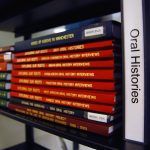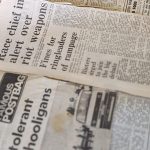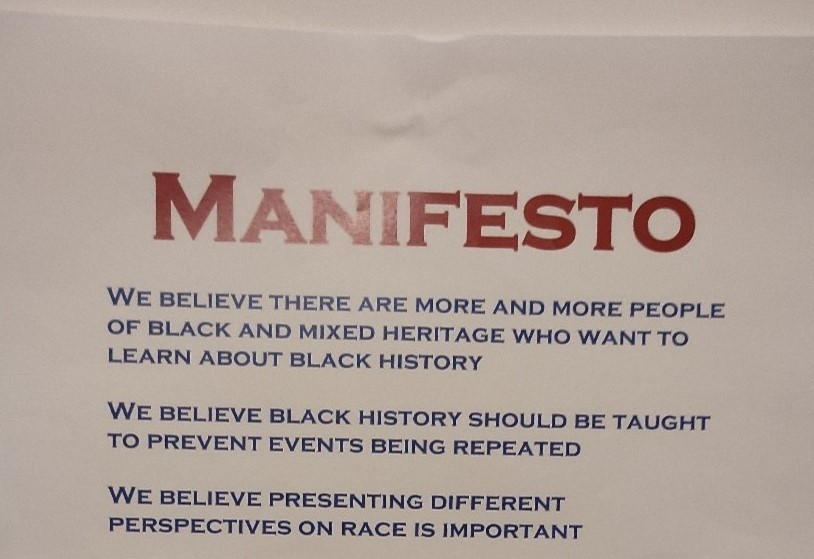The uprisings in Moss Side took place in 1981, a year when Black communities and their allies protested in organised and spontaneous ways against systemic racism, brutal policing of Black communities and racist violence. Whilst many people lived through the uprisings in Moss Side and have clear memories of what led up to the disturbances as well as what happened afterwards, many young Mancunians frequently hear about the “riots” but know little about the context and events. We thought 2021, the fortieth anniversary, was a good point to run a project inviting young people to explore the archive records we hold and to learn more about the conditions in Moss Side at the time, as well as thinking about Black communities in Manchester today.
Our Collections Engagement Officer Maya Sharma led the project, working with freelancer Tian Glasgow. The Louise Da-Cocodia Education Trust brought a group of young participants from their Saturday School.
The uprisings unsurprisingly feature heavily in our archives, and we were able to bring a range of archive documents to the young people. Our Archivist Lianne Smith introduced a set of key records from the Elouise Edwards collection (GB3552.5) which included minutes and press releases from the Moss Side Defence Committee, posters from the Roots Festival which took place from 1977-1988
“I really enjoyed learning about the history of the Black community in Moss Side”
The young people had a number of questions about the events, and we put these to local historian, writer and Black History educator Linford Sweeney. Linford shared his personal experiences of the Uprising, as well as helping the young people understand really important contextual information such as the oppressive policing and liberal use of the “sus law” to harass Moss Side residents.
“I liked learning about the history of the place I’m from, as I don’t really know much about the place I grew up in.”
We then invited the young people to reflect on Moss Side in 1981 and think about the community now, as well their lives as young Black and mixed race people growing up in Manchester. This lead to lively discussions about the limited way in which Black history is taught, and the young people created a Manifesto which sets out their views on this.

We also asked the young people to explore the RACE Centre’s extensive library and choose a set of books which they’d recommend to other young people and the wider community.
This resulted in a varied and engaging reading list, which we will share separately. Participants also wrote about why they’d made their choices:
Race, Class and Gender: Common Bonds and Different Voices
“I chose this book because it talks about there being a food chain in every category of people and there is the bottom (those that are treated worst) of each. SO even if you’re in a different category, you will share similar experiences with the other minorities”
Forward Groove
“It’s a book that talks about the history of jazz. I believe this book is a very very good book about the history of jazz, especially for young Black kids who want to learn more about their race and its history”
Finally, we held a Sharing Event at the library, where the young people came in with their parents, carers and siblings. We showcased their work (including a short video) and invited their guests to take a look at some of our archives and the library collection. It was great to talk to their parents about the histories we’d explored. Many had personal memories to share and Moss Side connections.
“I liked that we had lots of open conversations”
The young people gave entirely positive feedback on the project, with several participants asking for follow on activities. We hope to build on the project with more opportunities for young people to explore our archives and library.
Maya reflected on the event:
I have very mixed feelings at the end of the project: whilst I really enjoy working with engaged and curious young people who want to know more about their communities’ histories, I am left reflecting on why they are not being offered similar opportunities at school. The RACE Centre and the LDET will always have a role in supporting young people of colour to explore their roots, but I wish our work complemented work already being done in school, rather than trying to respond to the significant gaps and silences when it comes to teaching Black and Brown histories.
Tian commented:
Maya and I went into the project with the young people from Louise DaCocodia Trust with a strong ethic of collaboration. We wanted to introduce the young people to the archive, specifically the events of 1981 in Moss Side but we also wanted to hear what they thought about Moss Side now. After only one session we’d already been able to gather that the group were fascinated by the amount of history that isn’t taught and has to be personally researched. I was particularly impressed with their political perspective on past and present; they astutely saw how many things that were highlighted as issues back then are still issues now. We had the confidence to let them lead where the following sessions went and by the end of the process the young people had learned what gems there were in the library, had a taster of the archive and been able to speak openly about the change they would like to see in their curriculum and why. The creation of the Provocation was a highlight for me as it arrived as a part of a brainstorm which took on an element of a group debate around the community past and present. All in all a really thoughtful and politically exciting short project!










